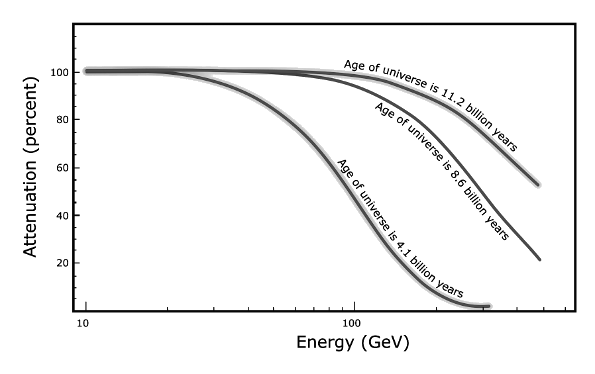
Cosmic Fog
November 16, 2012 There were two very significant cosmological discoveries in the last century. The first was the observation of universal expansion by Edwin Hubble and Vesto Slipher. The second was the discovery, by Arno Penzias and Robert Wilson, of the cosmic microwave background radiation. This was direct evidence for the Big Bang. This microwave background radiation was measured in great detail by the Cosmic Background Explorer satellite. microwave frequencies, since it pervades the entire universe and exists at a detectable background level. Astronomers have now examined another pervasive cosmic fog, more scientifically called extragalactic background light (EBL), using gamma rays.[1-4]. This cosmic fog consists of photons from early stars formed about 400 million years after the big bang, plus all light created thereafter. This observation was made by the Fermi Gamma-ray Space Telescope. To paraphrase a famous quotation, "Old photons never die, they bounce around the universe forever," thus forming the EBL. Or, as expressed in a NASA press release, the EBL contains "the total amount of light from all of the stars that have ever shone."[2] Like any background, the EBL sets a threshold of detectability for objects within it. As a result of the Fermi Telescope observations, this allowed an estimate of the average density of stars in the universe; and, thereby, the average distance between stars. The density is 1.4 stars per 100 billion cubic light-years, and the average stellar spacing is 4,150 light-years.[1-4] The Fermi Telescope team was able to make these estimates through study of 150 gamma ray blazars. These are intense sources of gamma rays, with energy greater that three GeV.[2] These gamma rays are created as matter falls into massive black holes within galaxies. The gamma ray photons have a probability of interaction with photons of the EBL and conversion into an electron-positron pair.[2] | The green dots show the locations of the 150 blazars in the EBL study. The plane of our Milky Way Galaxy runs through the middle. (Image: NASA/DOE/Fermi LAT Collaboration).[2] |
 |
| The more background light, the greater the attenuation. As the universe evolved, gamma ray absorption became more extreme. (Image: NASA's Goddard Space Flight Center).[2] |
References:
- M. Ajello, R. Buehler, A. Reimer, et al., "The Imprint of the Extragalactic Background Light in the Gamma-Ray Spectra of Blazars," Science, Advanced Online Publication, November 1, 2012, DOI: 10.1126/science.1227160.
- Francis Reddy, "NASA'S Fermi Measures Cosmic 'Fog' Produced by Ancient Starlight," NASA Goddard Space Flight Center Press Release, November 1, 2012.
- Thomas H. Maugh II, "Astronomers measure cosmic 'fog,' estimate space between stars," Los Angeles Times, November 1, 2012.
- Megan Garber, "Astronomers Read the Shadows of the Universe's Earliest Stars," The Atlantic, November 1, 2012.
- Cosmic 'Fog' Produced by Ancient Starlight Measured By Fermi, YouTube Video by NASA's Goddard Space Flight Center/Cruz deWilde, Nov 1, 2012.
- Francis Reddy, "NASA'S Fermi Measures Cosmic 'Fog' Produced by Ancient Starlight," NASA Goddard Space Flight Center Press Release, November 1, 2012.
